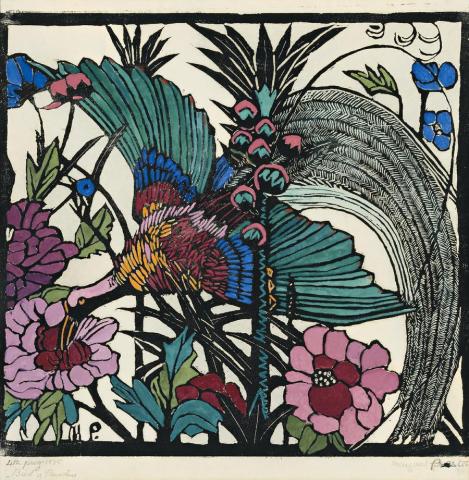BIRD OF PARADISE, 1925
Margaret Preston
hand-coloured woodcut
39.5 x 41.5 cm
Proof #4
signed, numbered and titled below image
initialled lower left within image
Private collection, Melbourne
Deutscher~Menzies, Sydney, 16 March 2005, lot 30
Private collection, Sydney
This, or other impressions: Thea Proctor and Margaret Preston Exhibition, Grosvenor Galleries, Sydney, 18 November – 2 December 1925, cat. 5
Exhibition of Woodcuts by Margaret Preston, Dunster Galleries, Adelaide, September 1926, cat. 55
Exhibition of Australian Art, Boans Ltd., Perth, 8 – 24 March 1932, cat. 56
A Survey of Australian Relief Prints 1900 – 1950, Deutscher Galleries, Melbourne, 13 April – 5 May 1978, cat. 26 (illus.)
The Art of Margaret Preston, Art Gallery of South Australia, Adelaide, 1980 and touring to major state galleries throughout 1981, cat. P5 (illus.)
Margaret Preston: Art and Life, Art Gallery of New South Wales, 29 July – 23 October 2005, and touring to major state galleries throughout 2006
Butler, R. & Deutscher, C., A. Survey of Australian Relief Prints 1900 – 1950, Deutscher Galleries, Melbourne, 1978, p. 20 (illus. another example)
North, I. (ed.), The Art of Margaret Preston, Art Gallery of South Australia, Adelaide, 1980, p. 52 (illus. another example)
Butler, R., The Prints of Margaret Preston: A Catalogue Raisonne, Australian National Gallery, Canberra, 1987, cat. 85, pp. 106–7, (illus. another example)
Edwards, D., Margaret Preston, Art Gallery of New South Wales, Sydney, 2005, (including CD-ROM Margaret Preston Catalogue Raisonne of Paintings, Monotypes and Ceramics), ref. p. 285, p. 81 (illus. another example)
Other impressions of this print are in the collections of the National Gallery of Victoria, Melbourne, and the National Gallery of Australia, Canberra
Margaret Preston's Bird of Paradise 1925 is one of her finest coloured woodcuts, deserving a place among the top ten or so of Australia's best prints. It is also her most exotic in its combination of subject, luxurious plumage, colourful flowers, and singular forms. In an oeuvre abundant in invention, this is no small claim. Moreover, the print has important admirers. Roger Butler, in his definitive catalogue raisonné of Preston's prints, described Bird of Paradise as 'the most exotic and decorative of the artist's early prints.'1 Other Preston aficionados Ian North, who curated 1980 the Art Gallery of South Australia's Preston retrospective, and Deborah Edwards, who gave us an update at the Art Gallery of New South Wales in 2005, both included impressions of this print in their exhibitions. Edwards described it as 'exceptional' as 'it imaged New Guinea's colour and fauna', noting compositional references to 'the decorative patterning of traditional Chinese flower and bird paintings, and a specific screen design by Japanese artist Honami Koyetsu.' Complimented with 'a vibrant "tropical" palette', Edwards also drew attention to the affinity between the detailing of the bird's tail feathers and 'the incised linear patternings of an Aboriginal shield' which Preston had seen in the Australian Museum'.2 As to be expected, other impressions of Bird of Paradise are in the two most important print collections in this country - the National Gallery of Australia, Canberra, and the National Gallery of Victoria, Melbourne. Preston's art does not dwell in the rarefied atmosphere of the ineffable. For her aesthetics grew out of the practical nature of her Scottish heritage, reflected in her direct approach, commanding of attention. This can be seen in the striking clarity within the complexity of the composition, and its overall balance, of movement and stillness. Static uprights contrast happily with lines that sweep and curve. As in her other great print, The Wheel Flower c.1929, Preston concentrated on an overall surface activity, the strong verticals of the plant forms providing a structure and balance within the dynamism of the composition created by the swirl of plumage and whirl of flowers. A masterpiece of design, it is a bravura work.
1. Butler, op. cit, p. 107
2. Edwards, op. cit, p. 105
DAVID THOMAS
